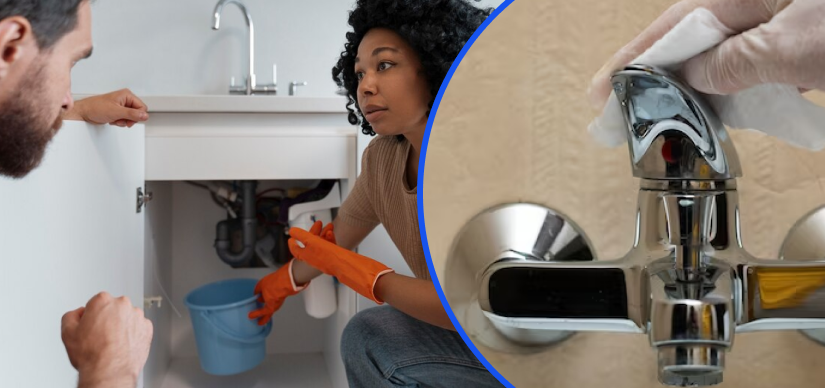It is indeed a persistent headache, listening to drip, drip, drip. Is it not?
However, one can put a stop to it.
If you think a leaky faucet can only be fixed by a plumber, you are mistaken. Following a simple DIY process can bring your faucet woes to an end.
So, gear up, learn the step-by-step process of how to fix a leaky faucet and apply. Follow the instructions to save water, reduce annoyance, and gain a sense of accomplishment with this simple DIY plumbing repair.
Tools and Materials
One must start with the tools and materials required for leaky faucet repair.
Tools:
- Adjustable Wrench: Used for loosening and tightening nuts and bolts.
- Plumbers Tape (Teflon Tape): Helps create a watertight seal on threaded connections.
- Screwdrivers: Flathead and Phillips screwdrivers for removing screws and disassembling the faucet.
- Bucket or Towels: To catch any water that may drip during the repair process.
- Plunger: Helpful in clearing any clogs in the drain that may be contributing to the leak.
- Plumber’s Putty: Seals gaps around the base of certain types of faucets.
- Pipe Wrench or Channel Locks: For gripping and turning pipes or nuts, especially in older plumbing systems.
- Plunger or Drain Snake: If the leak is associated with a clogged drain, these tools can help clear the blockage.
Materials:
- Replacement O-Ring or Washer: Common sources of leaks, especially in compression faucets. Choose a replacement that matches the size and the original.
- Replacement Cartridge or Valve: Required for cartridge or ball-type faucets if these components are worn or damaged.
- New Faucet: If the leak persists despite replacing individual components, you may need to install a new faucet.
- Plumber’s Grease: Lubricates moving parts and helps prevent future leaks.
- Faucet Repair Kit: Some faucets may have specific repair kits that include O-rings, washers, and other components needed.
- Pipe Dope or Pipe Thread Sealant: Seals and lubricates threaded connections, preventing leaks.
The first step for a faucet drip fix is to shut off the water supply to the faucet. Check if there are specific tools and materials required for repair or replacement. Consult an instruction manual or a hardware store professional for suggestions.
Faucet Leak Solutions Guide to Fix a Leaky Faucet Like a Pro
Step 1: Gather the Tools and Turn Off the Water Supply
DIY Faucet Fix begins by buying and collecting the tools and replacement parts for the repair. Turn off the main water supply.
Step 2: Plug the Drain
Use a sink stopper and a rag in the drain to cover the drain. This prevents small parts from going down the drain.
It also collects water that may come out during the repair.
Step 3: Identify the Type of Faucet
Faucets come in various types: compression, ball, cartridge, and ceramic disk. Understanding your faucet type is crucial for obtaining the correct replacement parts.
Step 4: Remove the Handle
Start removing the screw holding the faucet handle. Now, gently lift the handle to remove the faucet. If you see some handles attached with a set screw on the side, unassemble them as well.
Step 5: Inspect and Replace O-rings or Washers
For compression faucets, you’ll find rubber O-rings on the valve seat. Inspect these for wear or damage. If you have a cartridge or ball faucet, look for worn-out rubber seals or O-rings. Replace any damaged components with new ones.
Step 6: Remove the Valve Stem or Cartridge
Using an adjustable wrench, unscrew the valve stem or cartridge. Check for visible signs of damage after removing the cartridge. If you have a cartridge faucet, consider replacing the entire cartridge for a comprehensive fix.
Step 7: Replace Seals or Cartridge
If you have a compression faucet, replace the rubber seals and O-rings on the valve seat. For cartridges or ball faucets, replace the entire cartridge. Apply the plumber’s grease to the new parts before installing them to ensure smooth operation.
Step 8: Reassemble the Faucet
Carefully reinsert the valve stem or cartridge and tighten it with the adjustable wrench. Reattach the faucet handle, securing it with the screw. Ensure everything is snug, but avoid over-tightening, which can lead to further damage.
Step 9: Turn On the Water Supply
Turn on the water supply to check if the leak persists. Let the water run for a few minutes to remove initial debris and wait for a smooth flow.
Step 10: Check for Leaks and Test Operation
Turn on the faucet for a few seconds, and check the flow of water.
Now, turn off the faucet for a minute and turn back on to check the flow of water.
Step 11: Check if Leak Persists and Replace the Faucet
Home Faucet Repair may not always work. You may have to replace the entire faucet if leakage persists. This could be due to an old faucet and its components may be worn out.
Steps to Replacing the Faucet
Replacing comes when repairing a dripping faucet does not work out. You get an instant fresh look of your sink while improving functionality. These quick steps are the perfect walkthrough for replacing a faucet, without the need for a plumber.
Step 1: Gather Tools and Materials
Collect the necessary tools, including an adjustable wrench, plumber’s tape, and a basin wrench. Ensure you have the new faucet and any accompanying components ready.
Step 2: Turn Off the Water Supply
Locate the shut-off valves beneath the sink and turn off the water supply. Open the faucet to release any remaining water in the lines.
Step 3: Disconnect the Old Faucet
Using the appropriate tools, disconnect the water supply lines and remove the old faucet. Clean the sink surface to prepare for the new installation.
Step 4: Install the New Faucet
Follow the manufacturer’s instructions to install the new faucet. Use plumber’s tape on threaded connections to ensure a secure and leak-free fit.
Additional Tips on How to Fix a Leaky Faucet:
- Use a plumber’s tape for sealing the threads during reassembly. This creates a tight seal and helps to stop faucet leak.
- Clean the aerator screen if the water flow of the faucet is less. It may be due to sediment and debris accumulation.
- Know When to Call a Professional: If you’re uncomfortable with any step of the process or the leak persists, it’s advisable to call a professional plumber to avoid causing further damage.
Fixing a leaking faucet gives a sense of accomplishment and is an easy DIY task too. It is also rewarding in the sense of saving you money and water. The given steps are a complete guide to help you address common faucet issues and enjoy a leak-free, water fixture fix in your home.



